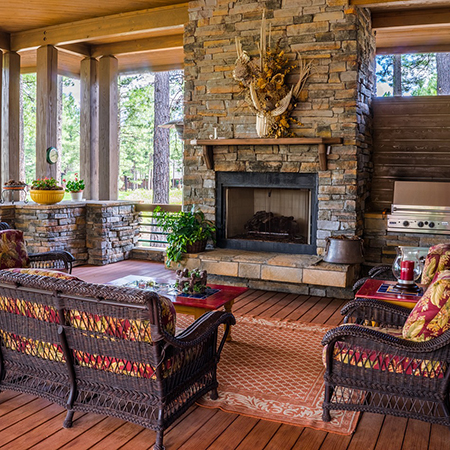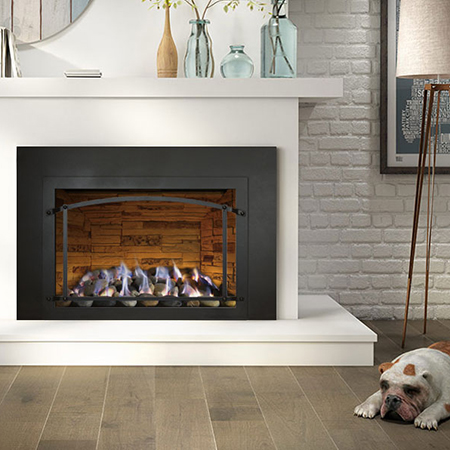Prevent Fireplace Heat Loss

That special ambiance created by a wood-burning fireplace is toasty and inviting, with the crackling logs, dancing flames, and woodsy aroma. On the practical side, however, a traditional open-hearth fireplace loses most heat up the chimney. You’re actually fortunate if even 10% of the heat produced by the fire goes into your home. The dirty truth about these well-loved fireplaces is that during the course of the year they likely increase, not reduce, overall heating costs. Good news, though! You can help prevent heat loss from your fireplace, and the following are some of the ways.
Clean Out the Creosote
Ensuring a clean-burning fire is a good start when you want to get the most from your fireplace. The chimney draft should work properly so that combustion materials exit the home. Some flammable, tar-like creosote is left behind in the flue with every wood fire you burn, however. Over time, if the creosote isn’t removed, it builds up layer upon layer. Finally, the creosote creates a chimney liner obstruction that prevents the toxic combustion gases from exiting the home.
Schedule annual chimney cleaning and inspection with chimney experts, as recommended by leading fire safety experts. This will ensure that your chimney is able to operate properly and fires can burn more efficiently. Your home and family will be safer, as well.
Burn Seasoned Wood
When wood is green, it’s fairly bursting with moisture. Fresh-cut wood should never be burned in the fireplace. Not only does green wood create excessive smoke, but the energy of the fire is used up by the moisture. Perhaps even worse, smoky fires leave a lot more of the grimy creosote in the chimney lining.
Only burn seasoned wood, which means that it is low in moisture. Firewood that is cut, stacked, exposed to sun and wind, and protected from rain usually takes six months to a year to dry out well enough for the fireplace. Seasoned wood provides your home with more heat because the fires are more efficient.
Add a Fireback
A “fireback” can be added to your fireplace to increase the amount of heat that enters the room. A fireback is a heavy steel or cast-iron plate that you place against the back wall of the fireplace. These accessories have been used since around 1500. Today, like back then, firebacks are usually embossed with vibrant images. The image may be a historical scene, coats-of-arms, Roman gladiators, or a Victorian floral motif. Antique firebacks were usually cast in sand and often have vertical or horizontal lines that were made by the wood mold.
What a fireback does is absorb and retain heat and radiate the heat back into the home. Long after the fire goes out, the fireback still retains warmth. According to experts on firebacks, the increase in the amount of heat from the fireplace into your home is from about 10% to 15%.
Add a Fireplace Insert
 The best way to increase the amount of heat from your fireplace is by having a fireplace insert installed. Inserts are custom-built for a specific fireplace, and professional installation is a must. An insert must be correctly installed so that it is safe and delivers optimal performance. The efficiency of your fireplace with an insert added increases to as much as 70%.
The best way to increase the amount of heat from your fireplace is by having a fireplace insert installed. Inserts are custom-built for a specific fireplace, and professional installation is a must. An insert must be correctly installed so that it is safe and delivers optimal performance. The efficiency of your fireplace with an insert added increases to as much as 70%.
Contact Dubuque Fireplace & Patio
NFI-certified chimney sweeps at Dubuque Fireplace & Patio can help you prevent heat loss from your fireplace. Contact our chimney experts for chimney inspections, chimney cleaning, fireplace insert installation, and even fireplace insert sales. The contact information is below.
Dubuque Fireplace & Patio
925 Century Drive, Dubuque, Iowa
Phone – (563) 582-5156
Chimney Specialists Inc.
869 Main Street, Highland, WI
Phone – (608) 929-4887 / Toll Free (800) 395-6660


 (563) 582-5156
(563) 582-5156


